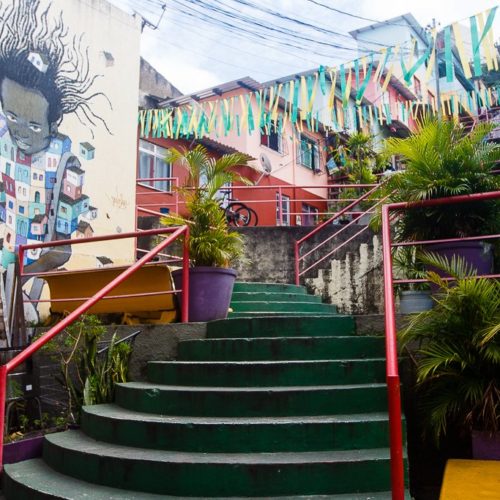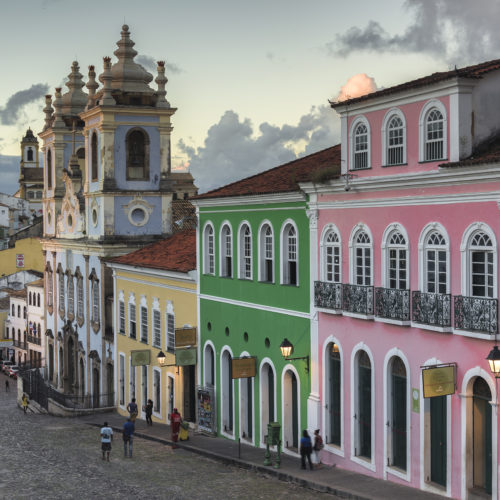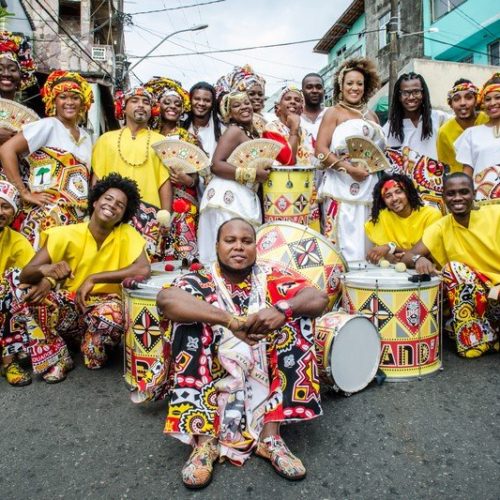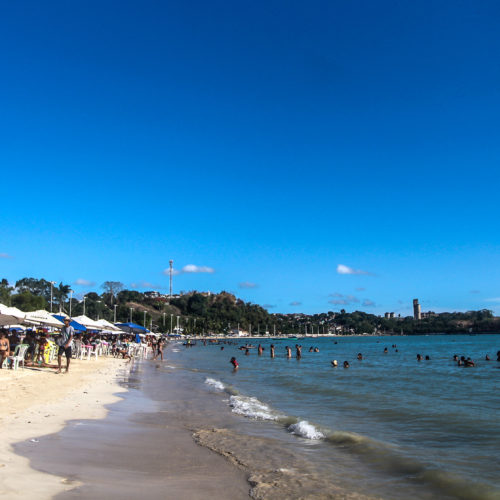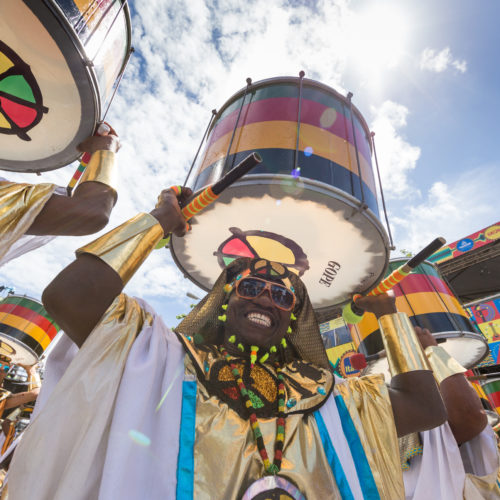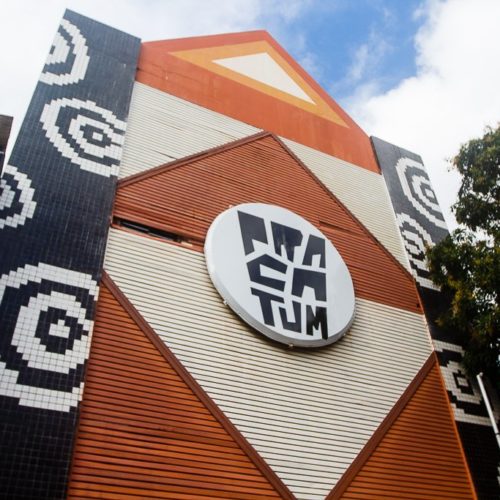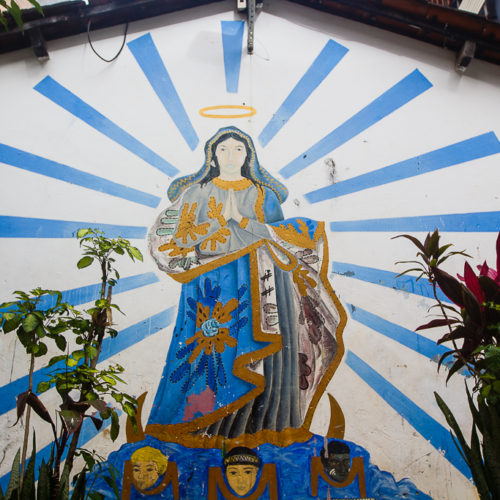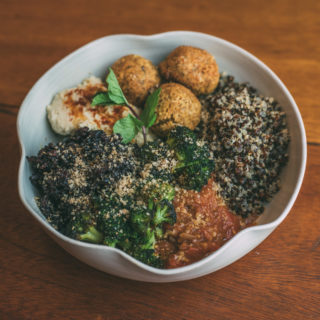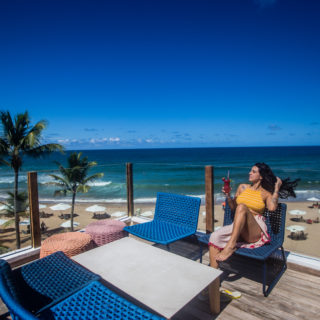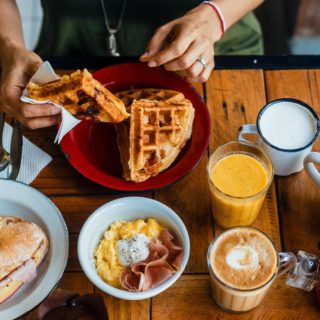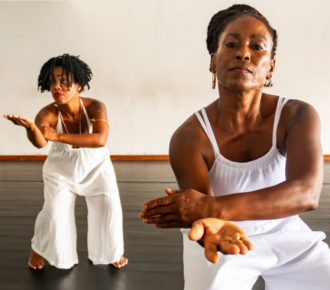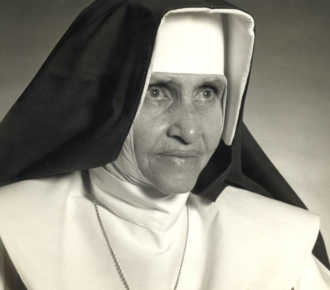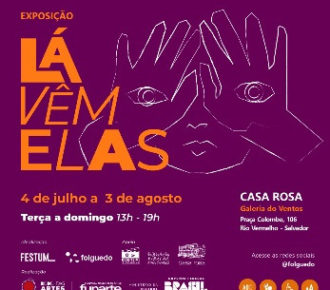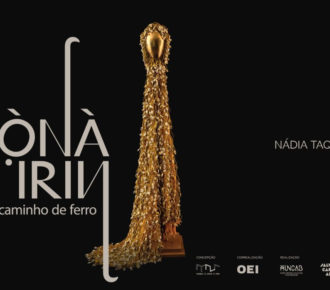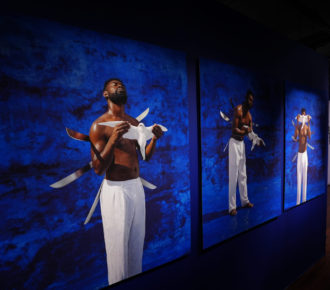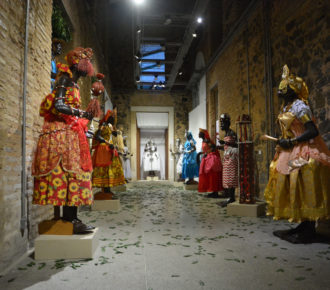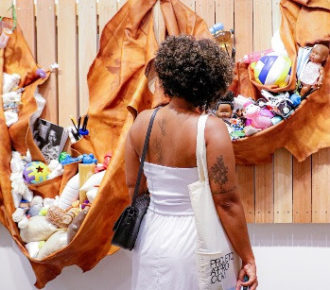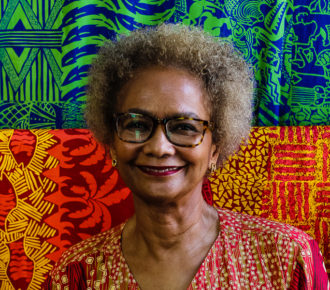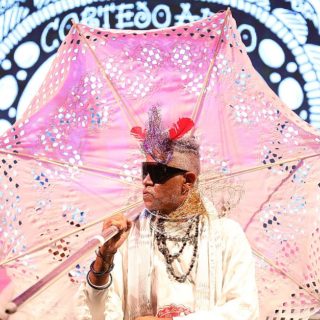
The history of music in the capital of Bahia mixes with famous neighborhoods
Salvador is a city full of history and a lot of music. Of course, the union between these two characteristics could only result in musical groups with a lot of authenticity, talent and beauty. In this itinerary, we gathered six districts of the capital that are the birthplace of great Bahian bands, such as Timbalada and Olodum, in addition to having several other attractions. It is certainly worth to learn a little more about these bands that are symbols of our musicality. Come check it out!
Timbalada – Candeal
Candeal is a neighboring neighborhood of Itaigara, Brotas, Pituba, Santa Cruz and Rio Vermelho. In the summer of 1991, it hosted, for the first time, the sound of percussionists from Timbalada (@timbaladaoficial). Under the command of Carlinhos Brown, who became one of the most important names in Afro-Bahian culture, the band, once small, now has more than 30 years of history, with a strong impact on the Bahian music industry. With its characteristic sound of the timbal, the instrument that inspired the name of the group, Timbalada, since its formation, enchanted crowds and spread its success around the world. Currently, it is one of the attractions of the traditional Salvador Carnival.
Learn a little about the history of the Candeal neighborhood
The Candeal neighborhood is divided into two parts: Candeal Pequeno and Candeal Grande. The first became famous due to Timbalada, in addition to social projects, such as the Associação Pracatum Ação Social (Pracatum). The region has a strong African heritage. Josefa de Santana, a black woman who was enslaved and freed from the Ivory Coast, arrived in Salvador in 1769 in search of her sisters who were also enslaved. Josefa didn’t find anyone, but decided to buy an area, which was later divided into lots to sell. In this place, the African root brought by the black woman started gaining strength. Music, food and customs would characterize, in the coming centuries, what we know today as Candeal.
In 1994, in the Candeal Pequeno region, Pracatum was born, which until today operates as a non-profit social organization, with the mission of “contributing to Candeal being a place of quality lives, through cultural and educational initiatives that value the knowledge and demands of the community, and share this model of social transformation with other entities”. Conceived by the artist Carlinhos Brown, the association develops actions in education, culture and community development. Learn more at this link.
What happens there…
In Candeal, visitors can experience cultural immersion and have lunch at local restaurants. Some festivals take place there, such as ”Candyall e Tal” and ”Da Lata”, and there is also the Candyall Guetho Square, a stage for a lot of creativity and rhythmic meetings, especially in the summer, when Timbalada rehearsals take place. So, our tip is that you go to Pracatum first and then continue visiting the neighborhood. Learn more at this link.
You can visit some establishments. Here are some indications: Valentins Restaurant (@rvalentins), which serves homemade food with the aim of pleasing your palate with that taste of mother’s/grandmother’s food, always made with lots of affection and love; Zafferano (@zafferanosalvador), which has a menu of antipasti, pasta, meats and more, in a contemporary and cozy environment, with a wine cellar; and it’s also worth visiting Lopandra Resto Bar (@lopandrarestobar), for those who like a more relaxed atmosphere.
Ilê Aiyê – Liberdade
It was in the Liberdade neighborhood that, in 1974, Ilê Aiyê (@blocoileaiye) was born, which is considered the first Afro block in Brazil and established itself as a pole of the fight against racism. Ilê produces its art with music, dance, illustration and clothing, and develops, in parallel, pedagogical extension projects. The Afro block was born in the midst of the military regime, resisting attacks and persecution, forming a consistent ideology to educate with its music.
The block’s creator is Antônio Carlos dos Santos, known as Vovô do Ilê, alongside Apolônio Lima. The Ilê Aiyê block aims to preserve, value and expand Afro-Brazilian culture, and today it is considered Heritage of Bahian Culture. In Afro dialect, Ilê Aiyê has a meaning full of coherence: “The house of all”. Unlike some blocks, Ilê is not limited to militancy songs played only during the carnival period. It is a broad project, which defends ethical issues, education and social transformation, offering art education, primary and secondary education to young people in the neighborhood. Days before Carnival, the biggest beauty contest and exaltation of black women in Brazil takes place: the Night of Black Beauty.
Learn a little about the Liberdade neighborhood’s history
The history of Liberdade neighborhood in Salvador begins in 1820, when the old Estrada das Boiadas, the neighborhood’s original name, was the passage of oxen that came from the hinterland and were sold at the Capuame Fair (where today is the current municipality of Dias D ‘Ávila) and even exported at the port of Salvador. On July 2, 1823, on the same road, the combatants who fought for the Independence of Bahia marched victoriously, which consolidated the end of Portuguese domain in Brazil. With that, the neighborhood came to be called the Liberdade neighborhood. Learn more at this link.
It was also there that Muzenza (@muzenzadoreggae) was born, another Afro block with a great Bahian expression. The Afro Block Muzenza, founded in 1981, brings in its history and sound the meeting of candomblé rhythms with Jamaican music. For 34 years in Salvador’s street carnival, the group – which originated in the Liberdade neighborhood and is now headquartered in Pelourinho – had several songs turned into hits by other Bahian singers, including: “Swing da Cor” and “Brilho e Beleza”, immortalized in the voices of Daniela Mercury and Gal Costa, respectively.
What happens there…
In addition to visiting the headquarters of Ilê, in Curuzu, you can also visit: Liberdade Square, which is dedicated to leisure for the community of Gengibirra de Baixo; Bairro Liberdade Salvador Shopping Mall; the Ladeira do Curuzu, one of the most famous slopes in the city, where the headquarters of the Ilê Aiyê Cultural Association is located; and the Japan Fair, which is another well-known spot. Only on Curuzu Street, there are sixteen Candomblé terreiros, among them the internationally known Ilê Axé Jitolu, founded by Mãe Hilda Jitolu. Find out about these and other experiences on the Salvador Capital Afro movement portal at this link.
Harmonia do Samba – São Caetano
Located between Fazenda Grande do Retiro and Lobato, the neighborhood of São Caetano is one of the most populous and poorest in Salvador, and is subdivided into several other locations, such as Capelinha, Boa Vista and Fonte da Bica. Specifically in Capelinha, in December 1993, Roque Cezar decided to put together a group to play songs that mix root samba with samba-reggae and regional rhythms from Bahia, combining the pandeiro and the cavaquinho with elements of percussion and wind. Together with maestro Bimba and other musician friends, they named the group “Harmonia do Samba” and began to perform at festivities.
In 1998, seeking to transform their passion for music into a profession, they invited Xanddy, who was lead singer of the group Gente da Gente, to take over the band’s vocals, and began to bet on an authorial repertoire. In 1999, the first album was released, from which hits like “Vem Neném”, “Agachadinho” and “Elevador” came out. The group turns 30 in 2023, but Xanddy announced his departure and the end of the band in 2022.
Learn a little about the São Caetano neighborhood’s history
A large part of the Capelinha neighborhood was formed on the city’s geological fault, which begins at the Lacerda Elevator and runs through the Lobato neighborhood. Until the middle of the 20th century, there was the Dique do Ladrão, which supplied water to the docks in Bahia. With the deactivation of the dike, an allotment was opened that started the settlement of the place. The origin of the name of the neighborhood is associated with a small church that already existed in the place since the time when the region was just a farm.
What happens there…
Today, in the neighborhood of Capelinha, there are schools, churches, Umbanda houses, Spiritist centers and Candomblé terreiros. Trading is diversified. There are shops, bakeries, grocery stores, funeral parlors, a boutique… On site, you will also find an ice cream parlor that sells one of the most famous popsicles in Salvador and which is already marked in the history of Bahia: the Capelinha popsicle. It’s difficult to visit the capital’s beaches, especially in summer, and not hear: “Here comes Capeliiiiiiinha, fruit flavor!”. Learn more at this link.
Ara ketu – Periperi
It was in Periperi that the band Ara Ketu (@araketu) appeared, a musical group founded on March 8, 1980. The band has its Afro essence, with a lot of struggle and resistance throughout all these years. It was Salvador’s carnival champion in 1981, 1982 and 1983. Ara Ketu was idealized by Vera Lacerda, history teacher and philosophy master, and her cousin Augusto César (deceased in August 2016), spiritual guru of several artists from Brazil.
The Ara Ketu afro block used to carry out social work aimed at its community. The songs were performed by other artists such as Banda Reflexu’s and Margareth Menezes. For example: the song “Uma história de Ifá” was recorded on Ara Ketu’s first LP, in 1987, and released on Margareth Menezes’ CD the following year, having great success in Brazil and abroad. The beaches in the Periperi region are beautiful and worth visiting.
Learn a little about the history of the Periperi neighborhood
The neighborhood of Periperi is located between the neighborhoods of Coutos and Praia Grande, in the Railway Suburb (Subúrbio Ferroviário) of Salvador. Its name is of indigenous origin and is associated with the multiplication of the reed plant in the flooded plain. It is in this neighborhood that the book “Home is the sailor” (1961), by Jorge Amado, takes place. Before the arrival of the Portuguese in the 16th century, Tupinambá Indians inhabited the region. During the 19th century, the neighborhood was occupied by farms. During the 20th century, Periperi was known for being an important summer place and housing for retirees, who retired to rest by the sea after years of service. With the implementation of industrial complexes and the Afrânio Peixoto Avenue (1971), the population increased.
What happens there…
The famous República Square is also part of the neighborhood and is one of the largest squares in Salvador. On weekends, the space is occupied by young people who enjoy music, dancing, chatting and flirting. There, cultural events always take place, and the neighborhood is the stage for the micareta Perifolia.
Olodum – Pelourinho
It was in Pelourinho that Olodum (@olodum_oficial) was born, one of the most famous blocks in the capital. The group emerged from a carnival playful moment on April 25, 1979, between friends Carlos Alberto Conceição, Geraldo Miranda, José Luiz Souza Máximo, José Carlos Conceição, Antônio Jorge Souza Almeida, Edson Santos da Cruz and Francisco Carlos Souza Almeida. What was meant to be a momentary leisure option for residents of the former Maciel-Pelourinho won over the world, becoming one of the most important institutions of Afro-Brazilian black culture, the Olodum Afro Block.
The group gained different sounds, transformed African musicality based on percussion and originated new rhythms, such as Ijexá, Samba, Alujá, Reggae, Forró and became a living expression of samba-reggae, a rhythm idealized by Neguinho do Samba. Olodum has established itself as one of the most prestigious Brazilian musical groups internationally, having already performed in more than thirty countries, on all continents. It has already enchanted artists such as Michael Jackson, Linton Kesey Johnson, Paul Simon, Julian Marley, Gal Costa, Caetano Veloso, Ivete, Gil, Tim Maia, Jorge Ben, Elba Ramalho, Daniela Mercury and Carlinhos Brown.
Learn a little about the history of Pelourinho
The history of the neighborhood is closely linked to the history of the city itself. Salvador was founded in 1549 by Tomé de Sousa, the first governor-general of Brazil, who chose the place where Pelourinho is located due to its strategic position – at the top, close to the port and with a natural barrier constituted by an abrupt elevation of the terrain, true wall of up to ninety meters high by fifteen kilometers long, facilitating the defense of the city. The neighborhood is the oldest in Salvador, and along the streets you can find buildings with centuries of history, churches that helped form the religiosity of the Brazilian people and some of the best restaurants in all of Bahia.
What happens there…
In Pelourinho, there are many things to discover. The place is one of the most important sights in the city, full of instagrammable places, including the headquarters of the Olodum block, which is available for visitation. When visiting, be sure to go to the squares, such as Largo Terreiro de Jesus and Largo do Pelourinho, in addition to the historic churches, museums, such as the House of Carnival and the Museum of Bahian Gastronomy. There is also the famous Model Market. So, take your time and spend the day getting to know every little bit.
Mudança do Garcia Block – Garcia
It was the moves of samba dancer Clementino Rodrigues, better known as Riachão (1921 – 2020), that made the name of the neighborhood win the world for his compositions. Cradle of samba, the neighborhood is still the seat of the traditional carnival block “Mudança do Garcia”. Historically, the block emerged in 1926, with the “Arranca-Tocos”, created by former police officers. It became “Faxina do Garcia” and then, in the 1950s, at the suggestion of then councilor Herbert de Castro, it gained its definitive name. Learn more at this link.
But the story of the name of the traditional block has another version: they say that Riachão’s father would have expelled a prostitute from the neighborhood. The woman’s move became “Mudança do Garcia” (Garcias’ moving), as it was done with a mix of samba and protest. The tradition, until today, remains the same: a parade that mixes samba, joy, representation and social protests.
Get to know a little of the Garcia neighborhood’s history
Garcia is one of the oldest and most traditional neighborhoods in Salvador and is located in the downtown area. It is one of the highest regions of the capital, more than 80 meters above sea level, and one of the most effervescent neighborhoods in the city in terms of culture. In addition to Colégio Dois de Julho, there are two other traditional educational spaces in the city: Colégio Antônio Vieira and Sacramentinas – both founded by Catholic missions. The neighborhood has a strong religious connection. It even houses the headquarters of the Archdiocese of Salvador and the Holy Family Chapel, former college of Dorotéias. Learn more at this link.
What happens there…
Garcia is known as a redoubt of the “partido alto” in Salvador and there are always good samba parties at the bar and restaurant Aconchego da Zuzu and at Casa de Pedra. It is also worth visiting the Varanda Burguer, for those who enjoy a tidbit.
Other articles you might like
To experience everything we tell in this text, you need to visit the City of Music of Bahia.
Meet new music talents from Salvador.
Take a complete tour of our history at the city’s Cultural Facilities.

